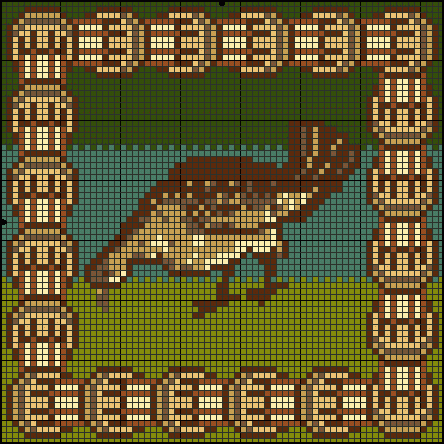|
I've charted several needlepoint patterns from photographs of the Bradford Table Carpet (English, late 16th c., Victoria & Albert, T.143-1928) and wished to have a physical example of how one of the designs might look in real life. The carpet is described in several books as being in silk threads on heavy linen or linen canvas in tent stitch at 20 stitches per inch.
Materials:
20-ct heavy needlework fabric (Zweigart "Lugana"), 52% cotton/48% rayon
12-ply silk floss (Rainbow Gallery "Splendor"), used in 4-ply strands
cotton velveteen backing
cotton batting
tassels:
12-ply silk floss (Rainbow Gallery "Splendor"), used in 4-ply strands
wooden beads, ½" diameter
brass screw eyes
Stitches:
tent stitch
detached buttonhole on tassel heads
Design:
I charted the bird from a color photograph of the Bradford Table Carpet in Embroidery in Britain from 1200 to 1750 by Donald King and Santina Levey. The border is a smaller scale adaptation of the borders on the carpet as seen in the same photograph and in photographs from other books.
Style:
Pincushions seem to have been a common needleworked artifact in the period. Several are shown in embroidery books. In particular, there is a small 2 ½" square pincushion attached to a purse (English, early 17th c., Victoria & Albert, T.316-1898) and a larger rectangular pincushion of about 10 ½" by 6" (English, late 16th or early 17th c., Victoria & Albert, T.317-1898). Both were worked with tent stitch in silk and both have corner tassels attached with metal rings or hooks.
Expediencies:
I was unable to find linen fabric or canvas of the desired count and used a cotton/rayon version instead, since what was important to me was to duplicate the stitch count of the original. I was also unable to find unspun wool to stuff the pincushion, which I believe to have been more likely used than cotton, although cotton was available as padding in this period. Since the background material and the stuffing are not seen, I was willing to make these substitutions.
The tassels turned out to be a bit larger than desired. Next time I'll look for smaller beads.
Discoveries:
I have a much increased appreciation of the effort involved in making the Bradford Table Carpet. The entire carpet is about 13 feet by almost 6 feet (400 x 175 cm). My small pincushion is about 3 ½" square (9 cm) and took approximately 20 hours of work for the needlepoint. This implies that the entire carpet could have taken more than 17,000 hours to complete (though they were certainly more experienced and thus, one hopes, faster).
I was also concerned about my ability to make Elizabeth style tassels, where a wooden form is covered with silk or metal threads and then with detached buttonhole stitching. The ones made turned out to be much less difficult than expected.
Sources:
Beck, Thomasina. The Embroiderer's Story: Needlework from the Renaissance to the Present Day. Devon: David & Charles, 1995.
Hanson, Carol, as Caryl de Trecesson. Designs, Period. 3rd edition. Malden, MA: Chanson Press, 1996. Privately published; now available on-line.
King, Donald, and Santina Levey. The Victoria & Albert Museum's Textile Collection: Embroidery in Britain from 1200 to 1750. New York: Canopy Books, 1993.
Schuette, Marie, and Signid Muller-Christensen. Text translated by Donald King. A Pictorial History of Embroidery. New York: Frederick A. Praeger, 1964.
Staniland, Kay. Embroiders. Toronto: University of Toronto Press, 1991. (Medieval Craftsmen series). Reprint, 1997.
Wardle, Patricia. Guide to English Embroidery [Victoria and Albert Museum]. London: Her Majesty's Stationery Office, 1970.
Pattern:
Uses 6 shades of brown and 3 shades of green; 74 squares x 74 squares.

| 
